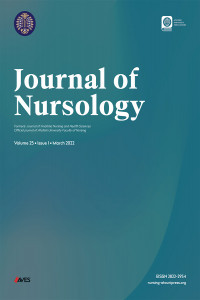KİLİS DEVLET HASTANESİ’NDE ÇALIŞAN HEMŞİRELERİN TÜKENMİŞLİK DÜZEYLERİNİN BELİRLENMESİ
ÖZETAmaç: Çalışmamızın amacı Kilis Devlet Hastanesi’nde çalışan hemşirelerin tükenmişlik düzeylerini belirlemektir.Gereç ve Yöntem: Araştırma 25 Ekim-15 Kasım 2010 tarihleri arasında Kilis Devlet Hastane’sinde çalışmakta olan ve çalışmaya katılmayı kabul eden 70 hemşireye uygulanmıştır. Araştırmada “Bilgi Formu” ve “Maslach Tükenmişlik Ölçeği (MTÖ)” kullanılmıştır. Verilerin değerlendirilmesinde sayı, yüzde dağılımı, Mann-Whitney U testi, Kruskal Wallis varyans analizi, tek yönlü varyans analizi ve student testi kullanılmıştır.Bulgular: Çalışmaya katılan hemşirelerin yaş ortalamaları 30.28 ± 4.49 dur. Hemşirelerin genel olarak Duygusal Tükenmişlik (DT) (16.15±6.82) ve Duyarsızlaşma (D) (4.52±3.05) puan ortalamalarının düşük düzeyde olduğu, Kişisel Başarı (KB) (10.80±4.75) puan ortalamasının ise yüksek olduğu belirlendi. Cerrahi birimde çalışan hemşirelerin DT puan ortalamalarının diğer bölümlerde çalışan hemşirelere göre daha yüksek (19.08±5.44) ve sonucun istatistiksel açıdan da anlamlı olduğu tespit edildi.(p=0.001) Mesleğini istemeyerek seçen hemşirelerin (4.97±3.49) D puan ortalamalarının isteyerek seçenlere (4.00±2.39)göre daha yüksek ve anlamlı olduğu görülmektedir (p=0.002). Sonuç: Sonuç olarak hemşirelerin tükenmişliklerini azaltmaya yönelik bireysel ve yönetsel düzeyde iyileştirmelerin planlanması ve yapılması gerekmektedir. Anahtar Kelimeler: Hemşire; tükenmişlik; tükenmişlik sendromu. ABSTRACTDetermination of Burnout Levels of the Nurses Working at Kilis State HospitalObjective: The purpose of our study is to determine the burnout levels of the nurses working at Kilis State Hospital.Material and Method: The study was performed between the dates of 25 October -15November 2010 the 70 nurses who agreeing to participate in the study and working at Kilis State Hospital. “Information Form” and “Maslach Burnout Inventory (MTÖ).” Evulation of data was used the number, percent distribution, the Mann-Whitney U test, Kruskal-Wallis ANOVA, one-way analysis of variance and Student's test. Results: The average age of the nurses participating in the study is 30.28 ± 4.49. It is determined that MTÖ subscale average score of the nurses is generally low emotional exhaustion (DT) (16.15±6.82), depersonalization (D) (4.52±3.05), and personal success (KB) (10.80±4.75) average score is high. It is determined that the nurses working in the surgical unit has higher DT average score compared to other units (19.08±5.44) and such result is significant (p=0.001). It is seen that D average scores of the nurses choosing the profession unwillingly (4.97±3.49) are higher and significant compared to the ones (4.00±2.39) choosing willingly (p=0.002).Conclusion: As a result, planning of improvements in individual and managerial level to reduce nurses' burnout is required. Key Word: Nurse; burnout; burnout syndrome.
Determination of Burnout Levels of The Nurses Working at Kilis State Hospital
Objective: The purpose of our study is to determine the burnout levels of the nurses working at Kilis State Hospital. Material and Method: The study was performed between the dates of 25 October -15November 2010 the 70 nurses who agreeing to participate in the study and working at Kilis State Hospital. “Information Form” and “Maslach Burnout Inventory (MTÖ).” Evulation of data was used the number, percent distribution, the Mann-Whitney U test, Kruskal-Wallis ANOVA, one-way analysis of variance and Student's test. Results: The average age of the nurses participating in the study is 30.28 ± 4.49. It is determined that MTÖ subscale average score of the nurses is generally low emotional exhaustion (DT) (16.15±6.82), depersonalization (D) (4.52±3.05), and personal success (KB) (10.80±4.75) average score is high. It is determined that the nurses working in the surgical unit has higher DT average score compared to other units (19.08±5.44) and such result is significant (p=0.001). It is seen that D average scores of the nurses choosing the profession unwillingly (4.97±3.49) are higher and significant compared to the ones (4.00±2.39) choosing willingly (p=0.002).Conclusion: As a result, planning of improvements in individual and managerial level to reduce nurses' burnout is required.
